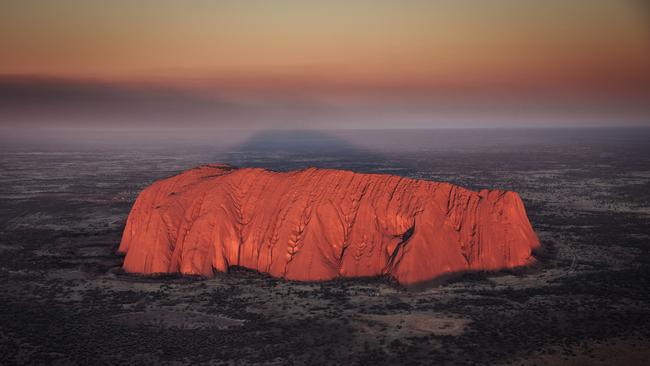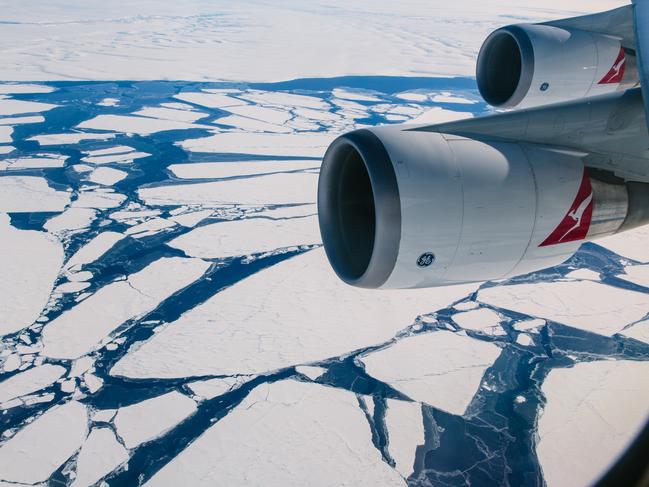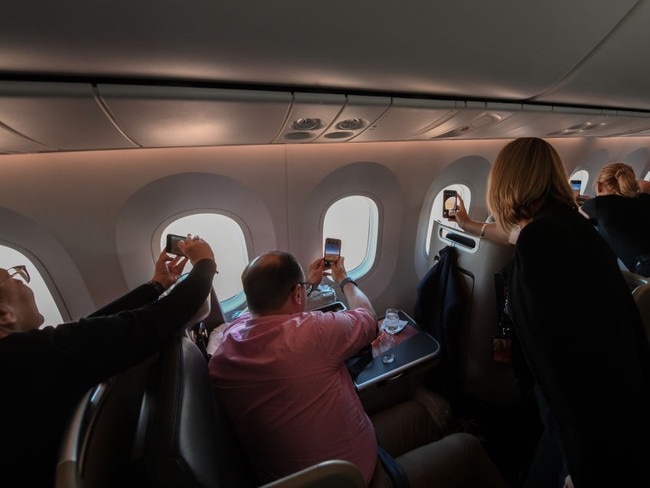Qantas scenic flight takes passengers to Uluru and Kata Tjuta
A scenic flight of fancy takes happy snappers to the spiritual heart of Australia.

Journeys to nowhere? It’s a sure sign of our restlessness that Qantas’s Scenic Flight Getaways concept has been so successful. A mini-holiday in the air instantly captivated lovers of plane travel and diehard aviation geeks who have been so keen to get airborne that the route hardly matters. Planes have been skirting picturesque coastlines and hinterlands and cruising over the Great Barrier Reef and Antarctica for the ultimate bird’s-eye of these fragile wonders.
On one journey last December, Qantas’s Mendoowoorrji, a Boeing 737-800 with Indigenous “flying art” livery, actually landed. Cries of jubilation rose from my fellow 110 passengers as we came to a stop at Uluru airport. It was my first flight in a year. Ahead lay 24 hours of sightseeing, Indigenous art classes, sunrise and sunset tours, guided canyon walks, desert dining and a surrealistic wander through Bruce Munro’s inspired Field of Light installation, shining amid the baked red earth and bunched outlines of desert oaks like a sci-fi set.

We looked to the heavens as the constellations were decoded by a chap who claimed his name was Luke “Star Talker”. We laughed a lot and slept little (but did so in our “free” Qantas business-class pyjamas).
On board, we snapped our cameras like a chorus of cicadas as the plane did low-level fly-bys of Sydney Harbour, passed over South Australia’s mysterious Marree Man geoglyph and sailed around Uluru and Kata Tjuta on low-level dips.
The commercial concept of flightseeing took off, as it were, about 25 years ago with Antarctic journeys of an average 12.5 hours. I remember the thrill of seeing the great white continent from the air, chatting to polar expeditioners on board about their rugged adventures, marvelling that many fellow passengers were dressed in thermals so bulky their arms almost stuck out at right-angles. Peters icy poles were handed out as snacks; these days, you might get a McVitie’s penguin biscuit with your afternoon tea. The jaunts are certified 100 per cent carbon neutral and this year will be aboard 787 Dreamliners, with bigger windows and touch-screens to watch videos and follow the designated route as scattered ice appears, then bergs, floes and the rugged topography of glaciers and ice shelves.

There are many critics of the enormous passenger footprints, even with no landing, and strong argument that we should all hit the pause button and just stay home. A call to inaction, if you like. A Singapore Airlines project dubbed “destination-less” flights was grounded last November after environmentalists mounted a campaign. The Singapore “staycation with wings” may not have got clearance for lift-off but the airline staged sell-out dinners aboard one of its A380 aircraft at Changi airport in October. Diners tucked into airline food and watched movies on the in-flight entertainment system. Singapore Airlines also trialled local home-delivered first-class and business-class “dining experiences” late last year.
It’s easy to scoff at such ersatz experiences but Qantas, too, has been thinking laterally, and its online store continues to chalk up record sales of flying kangaroo-motif pyjamas, Martin Grant-designed apparel, amenities kits and even in-flight bar carts (which sold out, apparently, before you could say champagne).
But there’s also a counter-argument that flightseeing doesn’t touch at-risk environments, has helped during COVID restrictions to keep airline crews in jobs and pilots certified, and could be considered educational, creating instant awareness of the environmental importance of, say, the Great Barrier Reef and the Antarctic continent. The 100 per cent carbon offsets of the Qantas Uluru overnighter were directed to traditional fire management projects operated by Indigenous-owned enterprises in the WA Kimberley.
While broader views are clearly divided, those who are fans of flights to nowhere seem united in their desire to get airborne. Qantas has other Australian destinations in its day-trip sights for 2021. Like it or not, this could well be the new age of armchair travel.

More to the story
Voyages Indigenous Tourism took advantage of COVID closures in the first half of 2020 to refresh its Ayers Rock Resort, Australia’s largest integrated accommodation and leisure facility.
Top of the list is the five-star, white-canopied Sails in the Desert, where accommodation has been refurbished with sparkling new ensuites and terrace category guestrooms equipped with smart outdoor furniture, including cocoon-style cane daybeds. The palette of graduated ochres and oranges mimics the landscape beyond and woven light fittings and carpets with swirled patterns hark to desert dunes and organic bush materials. It’s a democratic complex, with accommodation for all budget levels, including backpacker and family apartment-style; all are managed by Accor under its tiered brandings, from Pullman down to Novotel, Mercure and Ibis Styles.

A good upper-tariff choice is the 4.5 star Desert Gardens, a Novotel member that is not quite as glamorous as its Sails (Pullman) sibling but has the unique advantage of Uluru views from its Deluxe Rock View inventory and the appealing Mangata Bistro, named for the Pitjantjatjara word for desert quandong.
All facilities are loosely based around a town square and connected by shuttle buses and walkways; but the activities agenda is aimed at getting guests out and about, from desert dining experiences, camel riding and sightseeing tours at daybreak and twilight to tours of the 50,000 illuminated stems that create the Field of Light installation, in place since 2016 for a limited run but now extended indefinitely. Other highlights of the resort complex include Kulata Cafe, staffed by trainees from the National Indigenous Training Academy; interpretive garden walks led by rangers amid ghost gums and coolabahs; bush tucker demonstrations; and art and didgeridoo classes.
In the know
Dates have been released for 2021 Antarctica flightseeing journeys ex Sydney, Melbourne, Hobart, Adelaide, Brisbane and Perth, including a New Year’s Eve departure from the NSW capital.
Susan Kurosawa was a guest of Qantas.


To join the conversation, please log in. Don't have an account? Register
Join the conversation, you are commenting as Logout